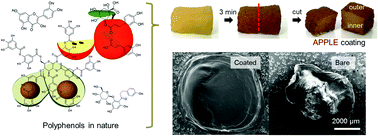A nature-inspired protective coating on soft/wet biomaterials for SEM by aerobic oxidation of polyphenols†
Abstract
Phenolamine networks are one of the major structural components in the insect exoskeletons called cuticles. An insect cuticle-inspired surface protective coating named “aerobic oxidation of polyphenol leading to artificial exoskeleton”, APPLE, is reported. The coating layer can be formed on any solid surface, because the oxygen in the air triggers the formation of the APPLE coating. The oxidized pyrogallol, called pyrogallol-quinone, is rapidly reacted with polyamine to form mechanically robust organic thin film networks. As some insect cuticles can be directly imaged under extreme conditions, such as in the vacuum chamber of a scanning electron microscope (SEM) without conventional metal deposition, the surface morphology of APPLE-coated materials (particularly soft ones) can also be imaged by SEM without conventional metal deposition. The APPLE coating is a pure organic flexible layer which is formed within a couple of minutes. Another advantage of the APPLE layer is the suppression of the vapor gas emission from the soft materials, allowing SEM imaging of wet samples such as hydrogels and living tissues. Considering that the traditional studies of phenolic molecules focus mostly on surface functionalization, our study opens a new research direction in which such phenolic coatings might be useful for applications in extreme conditions.



 Please wait while we load your content...
Please wait while we load your content...